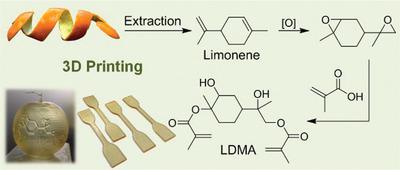当前位置:
X-MOL 学术
›
Macromol. Mater. Eng.
›
论文详情
Our official English website, www.x-mol.net, welcomes your feedback! (Note: you will need to create a separate account there.)
Low‐Viscosity Limonene Dimethacrylate as a Bio‐Based Alternative to Bisphenol A‐Based Acrylic Monomers for Photocurable Thermosets and 3D Printing
Macromolecular Materials and Engineering ( IF 3.9 ) Pub Date : 2020-06-30 , DOI: 10.1002/mame.202000210 Vitalij Schimpf 1, 2 , Anne Asmacher 1 , Andre Fuchs 2, 3 , Klaus Stoll 2, 3 , Bernd Bruchmann 2 , Rolf Mülhaupt 1, 2
Macromolecular Materials and Engineering ( IF 3.9 ) Pub Date : 2020-06-30 , DOI: 10.1002/mame.202000210 Vitalij Schimpf 1, 2 , Anne Asmacher 1 , Andre Fuchs 2, 3 , Klaus Stoll 2, 3 , Bernd Bruchmann 2 , Rolf Mülhaupt 1, 2
Affiliation

|
Bisphenol A glycidyl methacrylate (BisGMA) is well established as photocurable resin in dental restoratives and 3D printing. At present there are raising concerns regarding the estrogen‐mimicking bisphenol A (BPA) contamination of health care and consumer products. It is an important challenge to substitute BPA‐based resins for bio‐based cycloaliphatic monomers while lowering resin viscosity without sacrificing high stiffness and glass temperature. Particularly high viscosity is critical for 3D printing by photopolymerization. Unlike BPA the cyclic monoterpene limonene, extracted from citrus fruit peels, is safe in human uses. Herein it is reported on limonene‐based dimethacrylate (LDMA) tailored for 3D printing application and derived from limonene oxide (LO) and methacrylic acid (MA). Residual MA is converted into glycerol dimethacrylate (GDMA) serving as an in situ reactive diluent. The influences of temperature, catalysts, MA/LO stoichiometry, and the addition of glycidyl methacrylate (GMA) and magnesium oxide on the LDMA‐based resin performance are elucidated. As compared to BisGMA (560 Pa s) LDMA‐based resins exhibit significantly lower viscosity (5–117 Pa s) governed by the MA/LDMA molar ratio and the GMA addition. At 30 wt% LDMA content photocured resin yields thermosets having high Young’s Modulus (3.4–3.7 GPa), tensile strength (88–98 MPa), and glass transition temperature (119–135 °C), surpassing the performance of the corresponding BisGMA‐based resins.
中文翻译:

低粘度二甲基丙烯酸柠檬烯酯作为基于双酚A的丙烯酸单体的生物替代品,用于光固化热固性塑料和3D打印
双酚A甲基丙烯酸缩水甘油酯(BisGMA)在牙科修复剂和3D打印中已被确立为光固化树脂。目前,引起人们关注的是仿效雌激素的双酚A(BPA)对医疗保健和消费品的污染。在不牺牲高刚度和玻璃温度的情况下,降低树脂粘度的同时,用BPA基树脂替代生物基脂环族单体是一项重要的挑战。对于通过光聚合进行3D打印,特别高的粘度至关重要。与BPA不同,从柑桔果皮中提取的环状单萜柠檬烯在人类中是安全的。本文报道了专为3D打印应用量身定制的基于柠檬烯的二甲基丙烯酸酯(LDMA),其衍生自氧化柠檬烯(LO)和甲基丙烯酸(MA)。残留的MA被转化为二甲基丙烯酸甘油酯(GDMA),用作原位反应性稀释剂。阐明了温度,催化剂,MA / LO化学计量以及甲基丙烯酸缩水甘油酯(GMA)和氧化镁的添加对基于LDMA的树脂性能的影响。与BisGMA(560 Pa s)相比,基于MA / LDMA摩尔比和GMA的添加,基于LDMA的树脂表现出明显更低的粘度(5-117 Pa s)。LDMA含量为30 wt%时,光固化树脂产生的热固性树脂具有较高的杨氏模量(3.4–3.7 GPa),拉伸强度(88–98 MPa)和玻璃化转变温度(119–135°C),超过了相应的BisGMA-基树脂。阐明了甲基丙烯酸缩水甘油酯(GMA)和氧化镁对基于LDMA的树脂性能的影响。与BisGMA(560 Pa s)相比,基于MA / LDMA摩尔比和GMA的添加,基于LDMA的树脂表现出明显更低的粘度(5-117 Pa s)。LDMA含量为30 wt%时,光固化树脂产生的热固性树脂具有较高的杨氏模量(3.4–3.7 GPa),拉伸强度(88–98 MPa)和玻璃化转变温度(119–135°C),超过了相应的BisGMA-基树脂。阐明了甲基丙烯酸缩水甘油酯(GMA)和氧化镁对基于LDMA的树脂性能的影响。与BisGMA(560 Pa s)相比,基于MA / LDMA摩尔比和GMA的添加,基于LDMA的树脂表现出明显更低的粘度(5-117 Pa s)。LDMA含量为30 wt%时,光固化树脂产生的热固性树脂具有较高的杨氏模量(3.4–3.7 GPa),拉伸强度(88–98 MPa)和玻璃化转变温度(119–135°C),超过了相应的BisGMA-基树脂。
更新日期:2020-08-12
中文翻译:

低粘度二甲基丙烯酸柠檬烯酯作为基于双酚A的丙烯酸单体的生物替代品,用于光固化热固性塑料和3D打印
双酚A甲基丙烯酸缩水甘油酯(BisGMA)在牙科修复剂和3D打印中已被确立为光固化树脂。目前,引起人们关注的是仿效雌激素的双酚A(BPA)对医疗保健和消费品的污染。在不牺牲高刚度和玻璃温度的情况下,降低树脂粘度的同时,用BPA基树脂替代生物基脂环族单体是一项重要的挑战。对于通过光聚合进行3D打印,特别高的粘度至关重要。与BPA不同,从柑桔果皮中提取的环状单萜柠檬烯在人类中是安全的。本文报道了专为3D打印应用量身定制的基于柠檬烯的二甲基丙烯酸酯(LDMA),其衍生自氧化柠檬烯(LO)和甲基丙烯酸(MA)。残留的MA被转化为二甲基丙烯酸甘油酯(GDMA),用作原位反应性稀释剂。阐明了温度,催化剂,MA / LO化学计量以及甲基丙烯酸缩水甘油酯(GMA)和氧化镁的添加对基于LDMA的树脂性能的影响。与BisGMA(560 Pa s)相比,基于MA / LDMA摩尔比和GMA的添加,基于LDMA的树脂表现出明显更低的粘度(5-117 Pa s)。LDMA含量为30 wt%时,光固化树脂产生的热固性树脂具有较高的杨氏模量(3.4–3.7 GPa),拉伸强度(88–98 MPa)和玻璃化转变温度(119–135°C),超过了相应的BisGMA-基树脂。阐明了甲基丙烯酸缩水甘油酯(GMA)和氧化镁对基于LDMA的树脂性能的影响。与BisGMA(560 Pa s)相比,基于MA / LDMA摩尔比和GMA的添加,基于LDMA的树脂表现出明显更低的粘度(5-117 Pa s)。LDMA含量为30 wt%时,光固化树脂产生的热固性树脂具有较高的杨氏模量(3.4–3.7 GPa),拉伸强度(88–98 MPa)和玻璃化转变温度(119–135°C),超过了相应的BisGMA-基树脂。阐明了甲基丙烯酸缩水甘油酯(GMA)和氧化镁对基于LDMA的树脂性能的影响。与BisGMA(560 Pa s)相比,基于MA / LDMA摩尔比和GMA的添加,基于LDMA的树脂表现出明显更低的粘度(5-117 Pa s)。LDMA含量为30 wt%时,光固化树脂产生的热固性树脂具有较高的杨氏模量(3.4–3.7 GPa),拉伸强度(88–98 MPa)和玻璃化转变温度(119–135°C),超过了相应的BisGMA-基树脂。



























 京公网安备 11010802027423号
京公网安备 11010802027423号